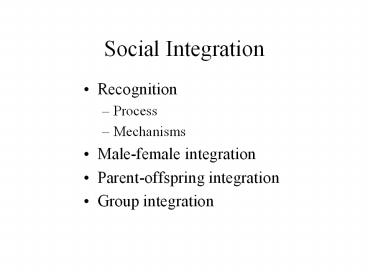Social Integration - PowerPoint PPT Presentation
Title:
Social Integration
Description:
Social Integration Recognition Process Mechanisms Male-female integration Parent-offspring integration Group integration – PowerPoint PPT presentation
Number of Views:1761
Avg rating:3.0/5.0
Title: Social Integration
1
Social Integration
- Recognition
- Process
- Mechanisms
- Male-female integration
- Parent-offspring integration
- Group integration
2
Meerkat
3
Recognition Process
- Sender provides information
- Receiver perceives signal above background
- Receiver compares information in signal to a
model of target stored in memory - Receiver decides whether sender is target or not
- Receiver takes action in response to target
- Feed offspring or not
- Flee from predator or not
4
Limits on repertoire size
5
Recognition issues
- Difficulty of discrimination task depends on the
number of classes that must be distinguished - Number of classes depends on identification
level, i.e. sex, species, group, or individual - Recognition is never perfect
- Sender and receiver need not agree on amount of
information to transfer
6
Recognition mechanisms
- Spatial location
- e.g. treat offspring in nest as own
- Familiarity
- Individual level recognition requires learned
familiarity and requires complex signature
signals - Phenotype matching
- Ability to assign stimuli to classes of
relatedness relative to the receiver - Referent can be a known relative or oneself
- Allele matching
- Requires hypervariable locus with olfactory signal
7
Neighbor-stranger discrimination provides an
example of recognition by spatial location
- Neighbors song ignored when broadcast from
proper territory - Aggressive response when neighbors song
broadcast from different territory - Rule of thumb recognize neighbor when in own
territory, treat all other songs as if from
floaters
8
Vocal signatures
9
Kin recognition in salamanders
10
Multiple Histocompatibility Complex
- MHC is involved in cell-cell recognition
- Many loci exhibit high levels of heterozygosity
with many alleles - Permits kin recognition in many vertebrates
- Human leukocyte antigen (HLA) on chr 6
11
Mice and humans prefer alternate MHC
12
Male-female integration
- Species recognition
- Can be hard-wired since only one signal variant
needs to be recognized - Chemoreceptor sensitivity in some male moths
- Color sensitive eyes of some fish and butterflies
- Frequency sensitivity of some frogs
- Parental care permits imprinting
- Coordination of reproduction
- Female reproduction often needs stimulation by a
species-specific male signal and vice versa - Provides opportunity for male exploitation
13
Copulation synchronization
14
Pairbond behaviors
15
Triumph ceremony in Greylag geese
Males use ritualized display to chase
away competitors and then both sexes display
together
16
Duets
Carolina wren
Found in Monogamous species In dense
vegetation Keeps pair together Minimizes extra
pair cops Advertises territory
Rufous and white wren
Buff-breasted wren
17
Pheromone delivery in salamanders
Chin rubbing on female nares by male plethodon
Pheromone wafting by male newt
Chin rubbing on female back by male desmognathus
Forced copulation by male euproctis
18
Parent-offspring recognition
- Parental investment includes time and energy
devoted to offspring that increase offspring
survival while decreasing parental survival
and/or ability to reproduce - Predict recognition accuracy should by high
- Can select for signal complexity or enhanced
receiver discrimination or both
19
Pup recognition in Mexican free-tailed bats
20
(No Transcript)
21
Isolation call measurements
22
Call complexity and colony size
Log colony size
23
Isolation calls are heritable
24
Parent-offspring conflict
25
Group integration
- Social groups permit cooperation, but require
mechanisms for recognition - Group recognition
- Appeasement
- Coordination of group movements
- Worker organization in social insects
26
Group recognition vocalizations
- Vervet monkeys
- Bottlenose dolphins
- Killer whales
- Parrots
27
Groups have distinct calls
28
Females learn to match calls
Group 1
Group 2
Before
5 months after move
29
Appeasement signals
30
Group cohesion calls
Squirrel monkey
Golden lion tamarin
Pinyon jay
31
Coordination of group movement
32
Bee dances signal hive choice
Swarming distance covaries with dialect
33
Isoptera - all termites

